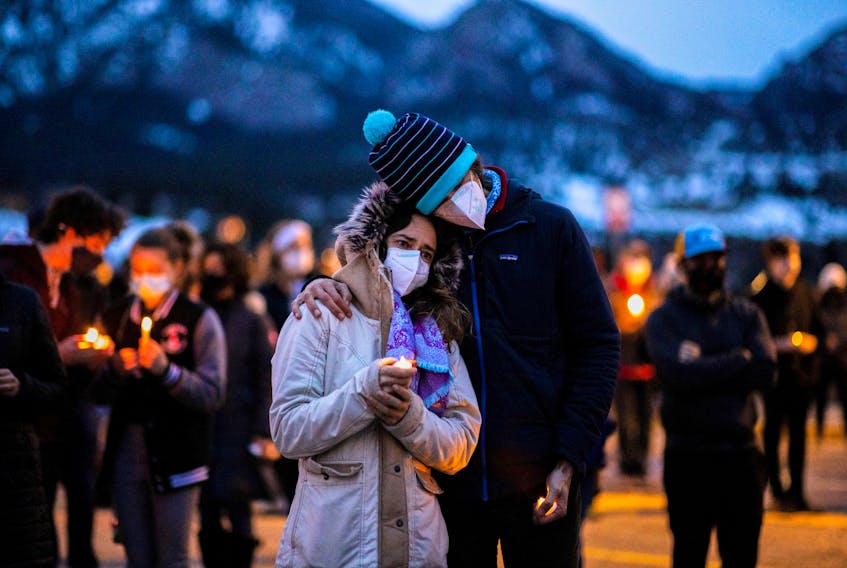BRUCE EVANS • Guest Opinion
Bruce Evans was born, raised and educated in Atlantic Canada — Newfoundland and Labrador and Nova Scotia. After a Dal MBA, he had a career in project finance in several cities — Ottawa, Toronto, Calgary, New York and L.A. — with a variety of international (Canadian, Japanese, French and Australian) financial players. He is happily retired in Arizona, volunteering, walking a dog named Charli and working to get a golf handicap moving south.
It is impossible to have an intelligent and informed debate without agreeing on the definitions of material terms. And debate is pointless unless both parties avoid hysteria, hyperbole and untruths.
The purpose of this column is less to debate the specifics of gun control in America, but to more properly define material terms, and to accurately describe the major elements affecting that issue.
Second Amendment
Let’s start at the beginning with the Second Amendment to the Constitution of the United States of America: “A well regulated militia, being necessary to the security of a free state, the right of the people to keep and bear arms shall not be infringed.”
Please don’t advance the argument that the right to bear arms is conditional upon membership in a militia. The Second Amendment has been debated before the U.S. Supreme Court at least five times since 1875. Two of the most recent decisions, District of Columbia v. Heller (2008) and McDonald v. City of Chicago (2010), both found that the clauses of the amendment were intended to be disjunctive and membership in a militia is not a condition precedent for the individual’s right to bear arms.
Assault weapons
People tend to get very excited and emotional about “assault weapons.” A rock, or a can of peaches, for that matter, can be an assault weapon when hurled at the head of an opponent.
But hey, what about that evil-looking AR-15 design? AR stands for “assault rifle,” after all! Nope. Sorry. In the late 1950s, a firearms company, ArmaLite, designed the AR model rifle, the designation being taken from the first two letters of the company’s name. Colt became the major manufacturer of AR-styled rifles in 1963.
They may look like M-4 or M-16 fully automatic (700 to 950 rounds per minute) military carbines, but that’s where the similarities end. ARs are semi-automatic — i.e., one trigger pull equals one shot fired, just like your Uncle Fred’s 30-06 moose-hunting rifle.
Most models use ammunition only very slightly larger than the .22-calibre varmint gun you keep out at the cottage. There is nothing inherent in the operation or design of an AR to make it more dangerous than other firearms. Automatic weapons — whereby one trigger pull equals multiple shots until the ammo is exhausted — have been illegal for private citizens to own since 1934. A very good example of sensible gun legislation. It dealt with what the firearm did, not what it looked like.
Gun-free zones
There is also the argument that gun-free zones are inherently safer than zones where people can personally carry firearms. Not so. Boulder, Colo., is arguably one of the more anti-gun jurisdictions in the U.S., with a list of laws and prohibitions to prove it. If I am a person with murderous ill-intent, am I more likely to vent my rage in a gun-free zone or in a place where it is very likely that private citizens will be armed? Take your time answering.
Are firearms bad?
There is nothing inherently evil in a firearm. It is a tool. Nothing more. Nothing less. The person holding it can be the wild card.
I own a 9mm semi-automatic pistol. I don’t own it because I want to kill people. It’s a well-designed and well-built machine. The heft of it is somehow satisfying. There is the skill-honing aspect of firing it accurately and safely in a controlled environment. And, yes, if absolutely necessary, it is an effective self-defence tool.
I am a member of the Arizona State Rifle and Pistol Association. I can vouch for the fact 99.99 per cent of firearms owners are mature, responsible people. At the shooting range or in a firearms-use seminar, three things are stressed: Safety. Safety. And safety.
Many of the new gun laws being proposed in America would negatively impact only the law-abiding folks. Is a felon or gangbanger going to be deterred by more stringent background checks or limitations on magazine capacity? Sure, he is.
Police protection
What about the argument that you don’t need a gun because the police have guns and can protect you? That’s partially true. I have huge respect for law enforcement. They will literally lay down their lives for us.
However, various studies of 911 call average response times in the U.S.’s non-rural areas vary from 10 to 18 minutes. The average response time for a 9mm pistol is 1,100 feet per second. No gun owner I know is of the “cowboy” variety, and would prefer to await police arrival than shoot an intruder at 3 in the morning. But it’s nice to have options.
In my Arizona grocery store, where any number of customers may be legally carrying concealed firearms, the carnage of a Boulder would likely have been ameliorated, if not outright avoided.
Mental health
No sane person can fail to be horrified by a mass shooting. It goes without saying. But it is that very emotionality that makes a rational Second Amendment argument more difficult.
Much of the nibbling around the edges of the issue by American politicians and anti-gun zealots avoids them having to deal with tougher issues — mental health being an especially highly charged third rail. It’s much easier to take rights away from law-abiding citizens than it is to tackle significantly more complicated problems. Banning so-called assault weapons is a simpler and lazier solution than trying to do something concrete about mental illness and its ties to violence.
Changing the Constitution
Talking about difficulty and laziness, let’s discuss how Americans could totally get rid of the Second Amendment, if that’s what they want.
There are two alternatives. By a two-thirds vote in each chamber, have Congress repeal the Second Amendment. Then have 38 of the 50 states ratify that measure, usually with a time period prescribed by the legislation, most often five years.
Alternatively, all 50 states can convene on their own, without precursor legislation, and if 38 vote for it, the amendment can be repealed or modified.
A heavy lift, to be sure. As it should be when the Bill of Rights is involved. Would anyone want their right to free speech, or religion, or a fair trial easily changed or even eliminated? I thought not.
We can debate whether or not there is a greater propensity toward violence in the U.S. than elsewhere. We can debate laws governing the physical characteristics of firearms. We can debate anything we want. But let’s do it without the hysteria and misinformation. And with respect for the rights of responsible people on either side of the argument.









